Auto/Coal plant Soot, Cancer rates, Heart Disease, all proven to be related.
A survey of todays webcams show a familiar pattern of clean
clear skies in the unpopulated areas of the world:
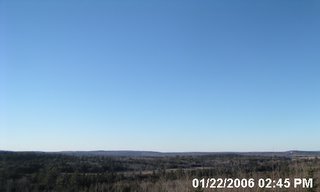
Found at: http://www.hazecam.net/allsites.html this
site is excellent for comparing out of the way locales
like the one above (Moosehorn in Northern Maine)
with populated areas such as Hartford Connecticut.
On 80% of days, when “regional haze” is not present,
you can see the
stark contrast well.
Below is todays camshot of Austin Tx. Found at:
http://www.instacam.com/showcam.asp?id=
KXANT&size=L
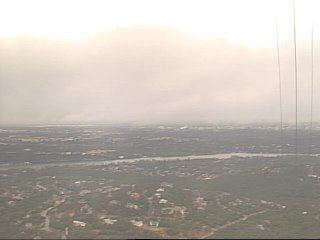
Next is Cape Canaveral, Florida looking usual.
http://www.weatherpictures.nl/webcam.html
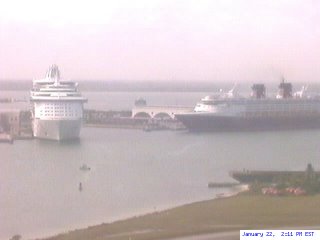
Compare that to San Salvador, El Salvador at just over
2,000ft elevation in Central America not far from the
coast. As you would expect, being far enough South of
1st world industrialized latitudes, and only having
thousands of miles of open water upwind of them, they
are usually in the Blue. Found at the same site as the
above Cape Canaveral cam.
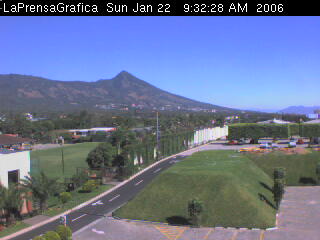
And to Yosemite park cam:
Found at:
http://www.yosemite.org/vryos/sentinelcam.htm

Of course these cams all reflect the usual conditions of
visibility (meaning Most of the time). To see that these
cams usually expected levels of Haze/Soot/pm2.5
(whatever you want to call fossil
fuel smoke), you can compare them to this map of US
“soot” levels. It is from the great folks at VIEWS
(Visibility Information Exchange Web System) at the
Colorado State: Note: the loop works better using
Netscape or Firefox Browser:
http://vista.cira.colostate.edu/views/Web/Annual
Summary/ContourMaps.aspx
At their main page on the left I select under the “annual
summary” section; “spatial patterns”, then on the right
under “Parameter” I select “MF”, which means Fine
Mass or PM2.5micron size particles and smaller.
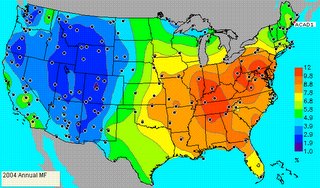
This one below shows the annual average Aerosol Bext
which is a way of saying the amount of light extinction
(reduced visibility) from Aerosols (particles in the air):
which includes all particles, not just the smaller 2.5
micron sized ones:
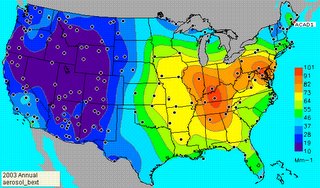
So please try to look around your environment more
often to take notice of when the soot levels are high,
and I'm sure you'll see that the feel-good
days are the clean clear blue ones. Here in the Eastern
US this only occurs when the wind speed is high enough
to blow it all away (mostly in the Fall and Spring when
the jet stream is overhead in the form of a Cold front).
See(1) at the bottom of the post.
In the Southeast, the Summer months are the worst
because the jet stream never dips this low in latitude
and the slow moving Gulf stream air prevails from the
South. This is when heart attack and stroke rates
climb and everyone around me is dragging, complaining
of a headache or some other ailment. When I often
point this out and inquire at to why everyone is so quite
and grouchy (even though I know why), they'll say
they're tired or it's sooo HUMID outside.
I then enjoy going online and pointing out to them
that the humidity is say 29% outside, and they can't
believe it! I know that if it were a clean day they'd all be
active and chatty. I try to show that when there is a
grey or blackish layer of haze above the horizon there
are over 6 to 8,000 ultrafine particles per cubic
centimeter of air, that are composed of toxic volatal
organic compounds (VOC's), heavy metals, lead,
mercury.. you name it. Link to a brochure on Visibility
and how to identify by the color of the haze what it
contains:
http://www.epa.gov/oar/visibility/introvis.pdf
Link to a tally of the thousands of tons of toxins
released in your area:
http://www.scorecard.org/
where you'll learn for example that there are 12,000,000
pounds of toxins released into the air, water and soil per
year in Mobile Alabama alone. There are also links from
each city to a list of what pollutants are emitted and
facts on each.
It's like breathing a diluted smoke of burning car-tires
... all day long. Of course the cancer and cardiovascular
disease rates are worse where the levels are greater.
It's not the ONLY factor obviously, but we now know
it is a major contributor. Look at the US map above of
pm2.5 and consider that the heart attack rate is
highest in the US states of Miss.,Tenn.,Kentucky., etc.,
and for those of you who think this is related to diet
and smoking, consider that the rate is lowest in
Puerto Rico!... where they eat the same saturated fats
and smoke at the same rate as mainland N. Americans,
but they alive on an Island in the carribean!
Your oxygen concentration is lowered as these
particles make it deep into the lungs, triggering
asthma attacks in some, heart attack and stroke in
others (all proven), chromosomal damages that
sometimes lead to cancer, birth defects in children
(UCLA 18year study of Los Angeles children),
increase in suicide, diabetic instability, and cardiac
arrythmias... I could go on and on. By the way all
of this is hard scientific data, peer reviewed journal
material... email me for links to Journal articles if
you must. People that live in cities with higher
average pm2.5 levels have higher C-reactive
protein levels, which is an indicator or marker of
the inflammatory process that accompanies the
damage to the blood vessals often leading to subsequent
plaque formation that is the disease we call CVD
(cardiovascular disease) which leads to heart attack
and stroke. Omega six fatty acids found in the corn
fed animalian saturated fat of "civilized" countries, and
cigarrette smoking will do the same thing: cause
microscopic damage to the cells of the lining of your
arteries that lead to scarring/hardening and plaque
formation.
Check out this link to an Air Quality site called
IMPROVE that has air quality monitors
throughout the US. Click on "loop" or ">" to see
the animation showing reducing visibility in
the Colorado rockies. In the Eastern half of the
US visibility is typically similar to the view at
the far right end of the loop (about 10km), and of
course the starting point of the loop is a good
day for the Western Rockies (200km):
http://vista.cira.colostate.edu/improve/
(1) http://www.ec.gc.ca/pdb/can_us/can_us_glozone
/section2_e.cfm
Go to the bottom third of the article to see how wind
direction and speed affect ozone levels. Ozone forms
from the fossil fuel combustion (automobiles and
coal plant) by-products Nitrogen oxides and Volatile
Organic Compounds reacting together with oxygen
because of sunlight... and therefore usually
accompanies high levels of Pm2.5/soot, unless of
course it's not sunny!
To see what the levels of soot are where you live
check out either the EPA's system of monitors
(which sadly only shows green and yellow circles
depending on whether you are below or above
about 20ug's/cubic meter of air. If levels are under 20
you'll be in the Green, and when above about
20... Yellow etc etc), or check out the much better system in
Texas that shows Actual hourly levels! Imagine
that, the best monitoring and reporting system in
the US is found in Texas!!! Maybe it's because they
are the most polluted state in the US in terms of
pounds of toxins released into the air, soil, and water.
There is one coal fired power plant in NE TX, Titus
county I believe, that releases from it's stacks more
Mercury into the air than any other plant in Canada, N and
S America.... about 2,000. pounds! It only takes
a 70th of a teaspoon of mercury to contaminate a
lake or pond to the point of giving it a fish advisory.
It's no wonder most lakes around NW Louisiana have
a mercury advisory against eating the fish. A Texas
president of a Fishing association recently remarked
what a shame it was to have so much mercury in the
lakes and streams that the fish could not be safely
routinely eaten.
US EPA pm2.5 monitoring system:
http://cfpub.epa.gov/airnow/index.cfm?action=airnow.showmap&pollutant=PM2.5&domain=super
&map=current_hour&standard=US&language=EN
Texas Commission on Environmental Quality:
http://www.tceq.state.tx.us/cgi-bin/compliance
/monops/texas_pm25
This soot is why one day I'll feel great with plenty of
energy and the next day be cranky and blah....
irregardless of temperature and humidity! Research
shows that there are anywhere from 8,000 to
100,000 ultrafine (nanometer sized) particles per
cubic centimeter of air depending on
how close you are to the road/cars/interstate/city
center etc!! It's partly why Tom Cruise, Lance
Armstrong and other hollywood folk can look so
young and vital (coastal NW Los Angeles where
these guys live and bike have a pm2.5 level sub
4 ug's). Downwind Eastern LA averages
near 30 ug's. Here in NW Lousiana we average
13ug's and clean clear blue Santa Fe, New Mexico
averages 3.6ug's! A bad head banging day here in
LA is in the 30's and a great day is sub 5ug's.
This month in Louisiana we've had an unusually
good month averaging about 7ug's. We feel really
good all around when levels are below 6, and start
to feel crappy when it's above 10 or 12.
It's partly why we feel good when we vacation
to the woods to stay in a tent on a hard
ground, and then say we felt soooo good, or
why we like being on or near the water (cleans
the air). The air quality is usually better in the
places we vacation.
In summary, breathing low grade levels
of soot all day long will affect your quality
of life, shorten your lifespan, age your skin,
respiratory, and cardiovascular systems.
Just look at any heavy smoker that's been at it for
a decade or so and see what you may look like in 20
years if you live in the "average" city. As a health
professional I've often made the observation that
those who live or have lived in heavily populated
cities or are smokers have very aged skin (pale,
wrinkled, blemished), with many damaged areas
from the oxidative toxic damage (take your anti-
oxidants!). Anything that constricts the blood
vessels of the skin will reduce the toxin removal
rate, and nutrient supply, not to mention the
simple fact that any cell will not do so well without
oxygen. People are pale and ashen looking when
pm levels high, and pink when they are low.
Common sense. My pulse ozimetry Oxygen satur-
ation level varies between good and bad days.
Please visit the EPA's GreenVehicles.com site
to see which cars emit less greenhouse effect
chemicals like VOC's/CO2/ and Soot. It's not just the
fuel economy that's important, it's the emmissions
to us that meke the bigger difference... unless you're dumb
and selfish. Other than the Hybrids (which are near
Zero emmissions vehicles!) you'd have to go to
California or the NE states to buy a SULEV
(super ultra-low emmissions vehicle).... which
approximates the excellent Hybrid near zero
standard.
http://www.epa.gov/greenvehicles/
The Sierra club has similar advice for saving
our water/food/air from these toxins and to
curb global warming:
http://www.sierraclub.org/globalwarming/
cleancars/
"The technology exists to stop global warming,
spark economic growth and save consumers
money. If we required auto makers to make
clean cars and light trucks that averaged 40
mpg, we would save more oil than we currently
import from the Persian Gulf, and we'd curb
emissions of the heat-trapping gases that cause
global warming." This same point is made in
Robert F. Kennedy's book "Crimes Against Nature": http://www.amazon.com/gp/product/00607468
74/qid=1137979001/sr=8-1/ref=pd_bbs_1/104-
4928860-7341549?n=507846&s=books&v=glance
I love the Bush face in the "fossilized" section on
the top left of the Sierra Club page on people evolving
beyond gas guzzling cars:
http://www.sierraclubplus.org/iwillevolve/
You decide:
Cleaner: Pm2.5 level = 3 ug's, Humidity 45%

Or Sooty: Pm2.5= 11 ug Humidity 62% :
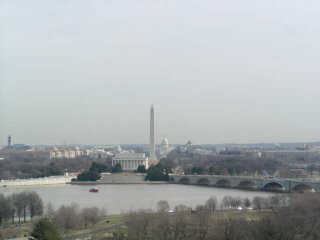
Found at the National Capital air quality cam site:
http://www2.nature.nps.gov/air/WebCams/parks
/nacccam/washcam.cfm

0 Comments:
Post a Comment
<< Home